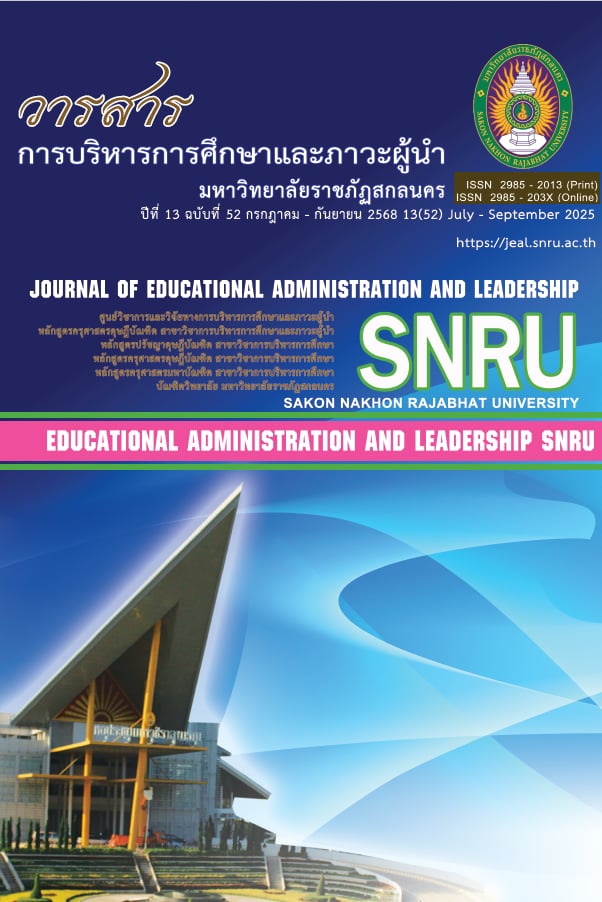

ภาวะผู้นำเชิงกลยุทธ์ในยุคดิจิทัลของผู้บริหารที่ส่งผลต่อประสิทธิผลการบริหารโรงเรียน สังกัดสำนักงานเขตพื้นที่การศึกษาประถมศึกษาสกลนคร เขต 1
Strategic Leadership in the Digital Age of Administrators Affecting the Effectiveness of School Administration Under Sakon Nakhon Primary Educational Service Area Office 1
ผู้แต่ง
มรกต บริสุทธิ์, สายันต์ บุญใบ, ชรินดา พิมพบุตร
Author
Morakot Borisut, Sayan Boonbai, Charinda Pimpabud
บทคัดย่อ
การวิจัยครั้งนี้มีความมุ่งหมายเพื่อศึกษา เปรียบเทียบ หาความสัมพันธ์ หาอำนาจพยากรณ์ และหาแนวทางการพัฒนาภาวะผู้นำเชิงกลยุทธ์ในยุคดิจิทัลของผู้บริหารที่ส่งผลต่อประสิทธิผลการบริหารโรงเรียน สังกัดสำนักงานเขตพื้นที่การศึกษาประถมศึกษาสกลนคร เขต 1 ตามความคิดเห็นของผู้บริหารสถานศึกษา และครูผู้สอน จำแนกตามสถานภาพการดำรงตำแหน่ง ขนาดโรงเรียน และประสบการณ์ในการปฏิบัติงานที่ต่างกัน กลุ่มตัวอย่างที่ใช้ในการวิจัย ได้แก่ ผู้บริหารสถานศึกษา จำนวน 70 คน และครูผู้สอนจำนวน 268 คน ประจำปีการศึกษา 2567 รวม 338 คน การกำหนดขนาดกลุ่มตัวอย่างตามตารางของ Krejcie and Morgan และใช้การสุ่มแบบหลายขั้นตอน เครื่องมือที่ใช้ในการเก็บรวบรวมข้อมูล ได้แก่ แบบสอบถาม 1 ฉบับ มี 3 ตอน ตอนที่ 1 ข้อมูลทั่วไปของผู้ตอบแบบสอบถาม ตอนที่ 2 แบบสอบถามเกี่ยวกับภาวะผู้นำเชิงกลยุทธ์ในยุคดิจิทัลของผู้บริหาร มีค่าอำนาจจำแนกอยู่ระหว่าง 0.874 - 0.937 และค่าความเชื่อมั่นเท่ากับ 0.967 และตอนที่ 3 แบบสอบถามเกี่ยวกับประสิทธิผลการบริหารโรงเรียน มีค่าอำนาจจำแนกอยู่ระหว่าง 0.857 - 0.902 และค่าความเชื่อมั่น เท่ากับ 0.950 และแบบสัมภาษณ์ 1 ฉบับ สถิติที่ใช้ในการวิเคราะห์ข้อมูล ได้แก่ ความถี่ ร้อยละ ค่าเฉลี่ย ส่วนเบี่ยงเบนมาตรฐาน การทดสอบ t - test ชนิด Independent Samples การวิเคราะห์ความแปรปรวนทางเดียว การวิเคราะห์ค่าสัมประสิทธิ์สหสัมพันธ์อย่างง่ายของเพียร์สัน และวิเคราะห์การถดถอยพหุคูณแต่ละขั้นตอน
ผลการวิจัยพบว่า
1. ภาวะผู้นำเชิงกลยุทธ์ในยุคดิจิทัลของผู้บริหาร โดยรวมอยู่ในระดับมาก
2. ประสิทธิผลการบริหารโรงเรียน โดยรวมอยู่ในระดับมาก
3. ผลการเปรียบเทียบภาวะผู้นำเชิงกลยุทธ์ในยุคดิจิทัลของผู้บริหาร จำแนกตามสถานภาพการดำรงตำแหน่ง พบว่า แตกต่างกันอย่างมีนัยสำคัญทางสถิติที่ระดับ .01 ส่วนจำแนกตามขนาดโรงเรียน และจำแนกตามประสบการณ์ในการปฏิบัติงานโดยรวม พบว่า ไม่แตกต่างกัน
4. ผลการเปรียบเทียบประสิทธิผลการบริหารโรงเรียน ตามความคิดเห็นของผู้บริหารสถานศึกษา และครูผู้สอน จำแนกตามสถานภาพการดำรงตำแหน่ง จำแนกตามขนาดโรงเรียน และจำแนกตามประสบการณ์
ในการปฏิบัติงานโดยรวม พบว่า ไม่แตกต่างกัน
5. ภาวะผู้นำเชิงกลยุทธ์ในยุคดิจิทัลของผู้บริหารกับประสิทธิผลการบริหารโรงเรียนมีความสัมพันธ์กันในทางบวกอย่างมีนัยสำคัญทางสถิติที่ระดับ .01 โดยมีความสัมพันธ์อยู่ในระดับปานกลาง (rxy = 0.702)
6. ภาวะผู้นำเชิงกลยุทธ์ในยุคดิจิทัลของผู้บริหาร จำนวน 5 ด้าน พบว่า มีจำนวน 2 ด้าน ที่สามารถพยากรณ์ประสิทธิผลการบริหารโรงเรียนโดยรวม ได้อย่างมีนัยสำคัญทางสถิติที่ระดับ .01 ได้แก่ ด้านการกำหนดวิสัยทัศน์
ในยุคดิจิทัล และด้านการใช้เทคโนโลยีดิจิทัลในการกำหนดทิศทางเชิงกลยุทธ์ โดยมีอำนาจพยากรณ์ ร้อยละ 51.00 และมีความคลาดเคลื่อนมาตรฐานของการพยากรณ์เท่ากับ .37119
7. แนวทางการพัฒนาภาวะผู้นำเชิงกลยุทธ์ในยุคดิจิทัลของผู้บริหาร จำนวน 2 ด้าน คือ 7.1) การกำหนดวิสัยทัศน์ในยุคดิจิทัล ดำเนินการโดยผู้บริหารต้องมีความรู้และทักษะด้านเทคโนโลยีดิจิทัล เพื่อวิเคราะห์ข้อมูลและกำหนดวิสัยทัศน์ที่สอดคล้องกับอนาคตส่งเสริม พัฒนาทักษะดิจิทัลให้บุคลากร สร้างเครือข่ายการเรียนรู้ มีการพัฒนาตนเองอย่างต่อเนื่องเพื่อเพิ่มประสิทธิภาพการบริหารงานในยุคดิจิทัล 7.2) ด้านการใช้เทคโนโลยีดิจิทัลในการกำหนดทิศทางเชิงกลยุทธ์ดำเนินการโดย ผู้บริหารนำเทคโนโลยีดิจิทัลมาใช้ในการบริหารงานอย่างมีกลยุทธ์ พร้อมพัฒนาทักษะดิจิทัล ส่งเสริมบุคลากร สร้างวัฒนธรรมที่ยืดหยุ่นต่อการเปลี่ยนแปลง ควบคู่กับการให้ความสำคัญด้านความปลอดภัย ติดตามแนวโน้มเทคโนโลยีเพื่อเพิ่มประสิทธิภาพองค์กร
Abstract
This research aimed to study, compare, find relationships, find predictive power, and identify approaches to developing strategic leadership in the digital age among administrators, which impacts school administration effectiveness under the Sakon Nakhon Primary Educational Service Area Office 1. This research, based on the opinions of school administrators and teachers, was categorized by tenure status, school size, and work experience. The sample consisted of 70 school administrators and 268 teachers for the 2024 academic year, totaling 338 participants. The sample size was determined according to Krejcie and Morgan's table and a multistage random sampling technique. The data collection tool consisted of a single questionnaire with three sections: Section 1: General Information of Respondents; Section 2: Questionnaire on Strategic Leadership in the Digital Age of Administrators, with a discrimination power between 0.874 and 0.937 and a reliability of 0.967; and Section 3: Questionnaire on School Administration Effectiveness. The discriminant power was between 0.857 - 0.902 and the reliability was equal to 0.950 and 1 interview form. Statistics used in data analysis included frequency, percentage, mean, standard deviation, Independent Samples t-test, one-way analysis of variance, Pearson's simple correlation coefficient analysis and multiple regression analysis at each step.
The results of the research found that
1. The overall strategic leadership in the digital age of administrators was at a high level.
2. The overall effectiveness of school administration was at a high level.
3. The results of the comparison of the strategic leadership in the digital age of administrators classified by job position found that they were statistically significantly different at the .01 level. As for the classification by school sizes and overall work experience, they were not different.
4. The results of the comparison of the effectiveness of school administration according to the opinions of school administrators and teachers classified by job status, school sizes, and overall work experience, were not different.
5. The strategic leadership in the digital age of administrators and the effectiveness of school administration were positively and statistically significant at the .01 level, with a moderate relationship (rxy = 0.702).
6. The strategic leadership in the digital age of administrators in the 5 dimensions found that 2 dimensions could predict the overall effectiveness of school administration. Statistically significant at the .01 level, namely, in terms of vision setting in the digital age and the use of digital technology in strategic direction setting, with a forecasting power of 51.00 percent and a standard error of forecasting of .37119
7. Guidelines for developing strategic leadership in the digital age for administrators 2 aspects: 7.1) Vision setting in the digital age, carried out by administrators who must have knowledge and skills in digital technology in order to analyze data and set a vision that is consistent with the future, promote and develop digital skills for personnel, create learning networks, and continuously develop themselves to increase the efficiency of administration in the digital age; and 7.2) Use of digital technology in strategic direction setting, carried out by administrators who use digital technology in management strategically, develop digital skills, promote personnel, and create a culture that is flexible to change, along with giving importance to safety, following technology trends to increase organizational efficiency.
คำสำคัญ
ภาวะผู้นำเชิงกลยุทธ์ในยุคดิจิทัล, ประสิทธิผลการบริหารโรงเรียนKeyword
Strategic Leadership in The Digital Age, Effectiveness of School AdministrationNotice: Undefined variable: dataSet in /var/www/html/ArticleView.php on line 116
Notice: Trying to access array offset on value of type null in /var/www/html/ArticleView.php on line 116
บทความทุกบทความเป็นลิขสิทธิ์ของ
Notice: Undefined variable: dataSet in /var/www/html/ArticleView.php on line 116
Notice: Trying to access array offset on value of type null in /var/www/html/ArticleView.php on line 116
เท่านั้น
กำลังออนไลน์: 13
วันนี้: 0
เมื่อวานนี้: 1,559
จำนวนครั้งการเข้าชม: 707,882
อาคารบัณฑิตวิทยาลัย ชั้น 2 ตำบลธาตุเชิงชุม อำเภอเมือง จังหวัดสกลนคร 47000
โทร/
แฟกซ์ 0-4297-0093
บรรณาธิการ: รองศาสตราจารย์ ดร.ไชยา ภาวะบุตร
ติดต่อ/สอบถาม: นายธีรเวทย์ เพียรธัญญกรณ์
โทร: 0-4297-0093